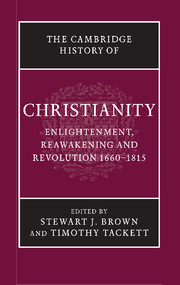Book contents
- Frontmatter
- Introduction
- PART I CHURCH, STATE, AND SOCIETY IN THE EUROPEAN WORLD, 1660–1780
- PART II CHRISTIAN LIFE IN THE EUROPEAN WORLD, 1660–1780
- PART III MOVEMENTS AND CHALLENGES
- PART IV CHRISTIAN DEVELOPMENTS IN THE NON-EUROPEAN WORLD
- 19 Christianity in Iberian America
- 20 British and French North America to 1765
- 21 Christianity in Africa
- 22 Christianity in south and south-east Asia
- 23 Christianity in East Asia
- 24 Christian encounters with other world religions
- PART V REVOLUTION AND THE CHRISTIAN WORLD
- Chronology
- Bibliography
- Index
- References
19 - Christianity in Iberian America
from PART IV - CHRISTIAN DEVELOPMENTS IN THE NON-EUROPEAN WORLD
Published online by Cambridge University Press: 28 March 2008
- Frontmatter
- Introduction
- PART I CHURCH, STATE, AND SOCIETY IN THE EUROPEAN WORLD, 1660–1780
- PART II CHRISTIAN LIFE IN THE EUROPEAN WORLD, 1660–1780
- PART III MOVEMENTS AND CHALLENGES
- PART IV CHRISTIAN DEVELOPMENTS IN THE NON-EUROPEAN WORLD
- 19 Christianity in Iberian America
- 20 British and French North America to 1765
- 21 Christianity in Africa
- 22 Christianity in south and south-east Asia
- 23 Christianity in East Asia
- 24 Christian encounters with other world religions
- PART V REVOLUTION AND THE CHRISTIAN WORLD
- Chronology
- Bibliography
- Index
- References
Summary
In the second half of the seventeenth century, colonial Catholicism came of age in the Iberian New World. Magnificently ornate churches physically marked cities and towns in both the Spanish and Portuguese dominions, while flamboyant religious festivals, processions, and elaborately constructed displays of religious drama marked them culturally. As in much of Europe, piety and popular devotion were centred on the cult of the saints, devotions to miraculous images, and displays of penitential rigour.
Relations between church and state had stabilized, as well, in both empires. Priests and bishops functioned as royal bureaucrats, with privileges, salaries, systems of promotion, and responsibilities defined in law. While there were conflicts – the sixteenth-century struggles in the Spanish Empire between the religious orders and the episcopacy never went away – clergy, in general, lived in a universe marked by social respect, security and unwavering routine.
The new ideas of the eighteenth century challenged these Baroque structures intellectually and politically. Rational individualism attacked the emphasis on mystery and community, and physiocrats attacked the utility of the political partnership. The governments of Charles III and Charles IV (1755–1808) of Spain translated these ideas into policy in an effort to transform the Habsburg Empire into a Bourbon state. They took numerous steps to reshape the administration of the church and officially discouraged Baroque spirituality. In Portugal, as well, the government of Joseph I (1750–77) and his chief minister, the Marqués de Pombal, pursued similar measures. But how much did these monarchs achieve administratively in the colonies? And what effect did official attitudes have on the role of religion in colonial culture, as well as on the continuing process of evangelization on the mission frontiers? Those are the issues that this chapter will examine.
- Type
- Chapter
- Information
- The Cambridge History of Christianity , pp. 371 - 391Publisher: Cambridge University PressPrint publication year: 2006
References
- 1
- Cited by

